Chapter 18: Questions & Answers
1 The role and responsibility of the financial manager

 Influence on objectives
Influence on objectives
Question
Discuss, and provide examples of, the types of non-financial,ethical and environmental issues that might influence the objectives ofcompanies. Consider the impact of these non-financial, ethical andenvironmental issues on the achievement of primary financial objectivessuch as the maximisation of shareholder wealth.
(15 marks)

2 Investment appraisal

 Breckhall
Breckhall
Question
Assume that you have been appointed finance director of BreckhallInc. The company is considering investing in the production of anelectronic security device, with an expected market life of five years.
The previous finance director has undertaken an analysis of theproposed project; the main features of his analysis are shown below.
Proposed electronic security device project
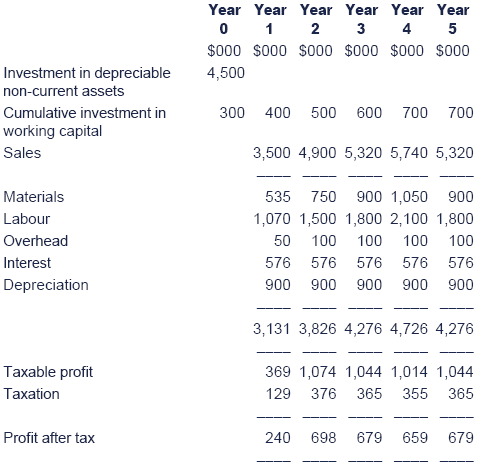
All of the above cash flow and profit estimates have been preparedin terms of present day costs and prices as the previous financedirector assumed that the sales price could be increased to compensatefor any increase in costs.
You have available the following additional information:
(1) Selling prices, working capital requirements and overhead expenses are expected to increase by 5% per year.
(2) Material costs and labour costs are expected to increase by 10% per year.
(3) Capital allowances (taxdeduction) are allowable for taxation purposes against profits at 25%per year on a reducing balance basis.
(4) Taxation of profits is at a rate of 35% payable one year in arrears.
(5) The non-current assets have no expected salvage value at the end of five years.
(6) The company’s realafter-tax discount rate (or weighted average cost of capital) isestimated to be 8% per year and nominal after-tax discount rate 15% peryear.
(7) Assume that all receipts andpayments arose at the end of the year to which they relate except thosein year 0 which occur immediately.
Required:
(a) Estimate the net present value of the proposed project. State clearly any assumptions that you make.
(16 marks)
(b) Calculate by how much the discount rate would have to change to result in a net present value of approximately zero.
(4 marks)
(Total: 20 marks)

3 The weighted average cost of capital
There are no additional questions on this chapter.
4 Risk adjusted WACC and APV

 Goddard Inc
Goddard Inc
Question
Goddard Inc a company in the educational sector is evaluating twonew projects. One is in the leisure industry and the other is in thepublishing industry. Goddard’s summarised balance sheets (statementsof financial position), and those of Cottons Inc and Blackwell Inc,quoted companies in the leisure and publication industry respectively,are shown below:
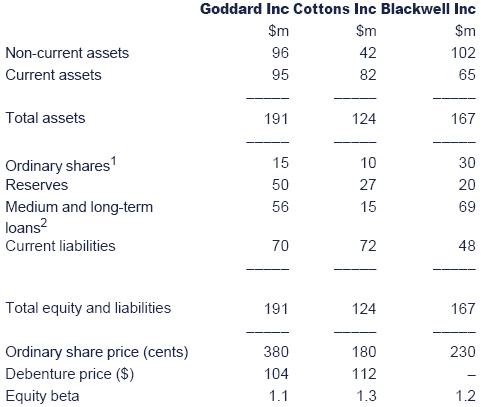
(1) Goddard and Blackwell 50 cents par value, Cottons 25 cents par value.
(2) Goddard 12% debentures 20X8-20Y0, Cotton 14% debentures 20Y2, Blackwell medium-term bank loan.
Goddard’s capital structure will remain unchanged if both oreither of the projects are undertaken. Goddard’s investors currentlyrequire a return on debt of 11%. The risk free rate of interest isestimated to be 6% per year and the market return 14% per year.Corporate tax is at a rate of 30% per year.
Required:
(a) Calculate the appropriatediscount rate to use for each of these projects. Explain your answer andstate clearly any assumptions that you make.
(10 marks)
(b) Goddard’s marketing directorsuggests that it is incorrect to use the same discount rate each yearfor the leisure project, as the early stages of the investment are morerisky and should be discounted at a higher rate. Another board memberdisagrees saying that more distant cash flows are riskier and should bediscounted at a higher rate. Discuss the validity of the views of eachof the directors.
(5 marks)
(Total: 15 marks)

5 Capital structure and financing
There are no additional questions on this chapter.
6 Dividend policy

 HGT Inc
HGT Inc
Question
HGT Inc is a UK based multinational company with two overseassubsidiaries. The company wishes to minimise its global tax bill, andpart of its tax strategy is to try to take advantage of opportunitiesprovided by transfer pricing.
HGT has subsidiaries in Glinland and Rytora.

The subsidiary in Glinland produces 150,000 graphite golf clubshafts per year which are then sent to Rytora for the metal heads to beadded and the clubs finished off. The shafts have a variable cost inGlinland of $6 each, and annual fixed costs are $140,000. The shafts aresold to the Rytoran subsidiary at variable cost plus 75%.
The Rytoran subsidiary incurs additional unit variable costs of $9,annual fixed costs of $166,000, and sells the finished clubs at $30each in Rytora.
Bi-lateral tax agreements exist which allow foreign tax paid to be credited against UK tax liability.
All transactions between the companies are in pounds sterling. TheRytoran subsidiary remits all profit after tax to the UK parent companyeach year, and the Glinland subsidiary remits 50% of its profit aftertax.
Required:
The parent company is considering instructing the Glinlandsubsidiary to sell the shafts to the Rytoran subsidiary at full cost.Evaluate the possible effect of this on tax and tariff payments, anddiscuss briefly any possible problems with this strategy.
(10 marks)

7 International investment and financing decisions

 Axmine
Axmine
Question
The managers of Axmine plc, a major international copper processorare considering a joint venture with Traces, a company owningsignificant copper reserves in a South American country. The proposedjoint venture with Traces would be for an initial period of four years.
Copper would be mined using a new technique developed by Axmine.Axmine would supply machinery at an immediate cost of 800 million pesosand 10 supervisors at an annual salary of £40,000 each at currentprices. Additionally Axmine would pay half of the 1,000 million pesosper year (at current prices) local labour costs and other expenses inthe South American country.
The supervisors’ salaries, local labour, and other expenses willbe increased in line with inflation in the United Kingdom and the SouthAmerican country respectively.
Inflation in the South American country is currently 100% per yearand in the UK, it is expected to remain stable at around 8% per year.The government of the South American country is attempting to controlinflation and hopes to reduce it each year by 20% of the previousyear’s rate.
The joint venture would give Axmine a 50% share of Traces’ copperproduction, with current market prices at £1,500 per 1,000 kilograms.Traces’ production is expected to be 10 million kilograms per year,and copper prices are expected to rise by 10% per year (in poundssterling) for the foreseeable future. At the end of four years, Axminewould be given the choice to pull out of the venture or to negotiateanother four-year joint venture, on different terms.
The current exchange rate is 140 pesos/£. Future exchange rates may be estimated using the purchasing power parity theory.
Axmine has no foreign operations. The cost of capital of thecompany’s UK mining operations is 16% per year. As this joint ventureinvolves diversifying into foreign operations, the company considersthat a 2% reduction in the cost of capital would be appropriate for thisproject.
Corporate tax is at the rate of 20% per year in the South Americancountry and 35% per year in the UK. A tax treaty exists between the twocountries and foreign tax paid is allowable against any UK taxliability. Taxation is payable one year in arrears and a 25%straight-line writing-down allowance is available on the machinery inboth countries.
Cash flows may be assumed to occur at the year-end, except for theimmediate cost of machinery. The machinery is expected to havenegligible terminal value at the end of four years.
(a) Prepare a report discussingwhether Axmine plc should agree to the proposed joint venture. Relevantcalculations must form part of your report or an appendix to it.
State clearly any assumptions that you make.
(20 marks)
(b) Explain whether you consider Axmine’s proposed discount rate for the project to be appropriate.
(5 marks)
(c) If, once the investment hastaken place, the government of the South American country imposed ablock on the remittance of dividends to the UK, discuss how Axmine mighttry to avoid such a block on remittances.
(5 marks)
(Total: 30 marks)

8 Option pricing

 Option valuation
Option valuation
Question
An investor holds 200,000 shares in D Inc and is considering buyingsome put options to hedge her investment. D’s current share price is$6. The risk free interest rate is currently 12% pa and the recentvolatility of D Inc shares has been 30% pa. She requires European putoptions with an exercise price of $5 for exercise in two years time.
Required:
(a) Calculate the value that the bank is likely to charge for 200,000 put options of the investor’s required specification.
(8 marks)
(b) Calculate the investor’schange in wealth if she buys 200,000 put options to hedge her portfolioand the share price in two years time is a) $3 per share or b) $10 pershare.
(4 marks)
(c) A friend informs theinvestor that she could achieve a safer position by selling call optionsto construct a delta hedge. Calculate the number of call options to besold to construct a delta hedge.
(3 marks)
(Total: 15 marks)

9 Strategic aspects of acquisitions

 Rayswood Inc
Rayswood Inc
Question
In a recent meeting of the board of directors of Rayswood Inc thechairman proposed the acquisition of Pondhill Inc. During hispresentation the chairman stated that: ‘As a result of this takeoverwe will diversify our operations and our earnings per share will rise by13%, bringing great benefits to our shareholders.’
No bid has yet been made, and Rayswood currently owns only 2% of Pondhill.
A bid would be based on a share for share exchange, which would be one Rayswood share for every six Pondhill shares.
Financial data for the two companies include:
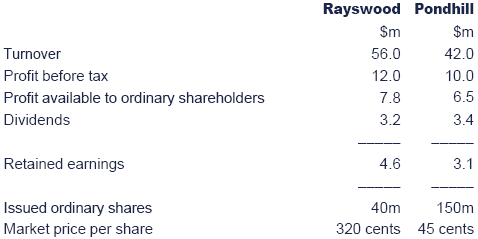
Rayswood 50 cents par value, Pondhill 10 cents par value.
A non-executive director has recently stated that he believes‘the share price of Rayswood will rapidly increase to $3.61 followingthe announcement of the bid.’
Required:
Explain whether you agree with the chairman’s and thenon-executive director’s assessment of the benefits of the proposedtakeover.
Support your explanation with relevant calculations, including yourassessment of the likely post acquisition share price of Rayswood ifthe bid is successful.
State clearly any assumptions that you make.
(15 marks)

10 Business valuation

 Predator
Predator
Question
The board of directors of Predator Inc is considering making anoffer to purchase Target Co, a private limited company in the sameindustry. If Target is purchased it is proposed to continue operatingthe company as a going concern in the same line of business.
Summarised details from the most recent set of financial statements for Predator and Target are shown below:
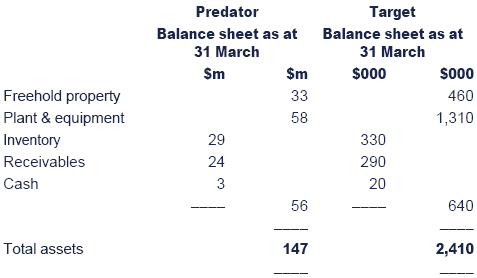
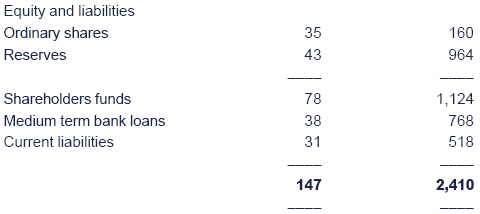
Predator, 50 cents ordinary shares, Target, 25 cents ordinary shares.

T5 is five years ago and T1 is the most recent year.
Target’s shares are owned by a small number of privateindividuals. Its managing director who receives an annual salary of$120,000 dominates the company. This is $40,000 more than the averagesalary received by managing directors of similar companies. The managingdirector would be replaced, if Predator purchases Target.
The freehold property has not been revalued for several years and is believed to have a market value of $800,000.
The balance sheet value of plant and equipment is thought toreflect its replacement cost fairly, but its value if sold is not likelyto exceed $800,000. Approximately $55,000 of inventory is obsolete andcould only be sold as scrap for $5,000.
The ordinary shares of Predator are currently trading at 430 centsex-div. A suitable cost of equity for Target has been estimated at 15%.
Both companies are subject to corporation tax at 33%.
Required:
Estimate the value of Target Co using the different methods ofvaluation and advise the board of Predator as to how much it shouldoffer for Target’s shares.
Note: There has been no increase in the share capital of Target over the last five years.
Why is this relevant?

11 Corporate failure and reconstruction

 Last Chance Saloon Inc
Last Chance Saloon Inc
Question
Last Chance Saloon Inc has experienced considerable losses in thelast few years, leading to a debit balance on its revenue reserves andthus a deterioration of its cash position. The company has developed awonder product to revive its fortunes. The wonder product will require atotal investment of $7 million. The finance director has drafted ascheme of reconstruction:
(1) Existing shareholders are to be offered a cash payment 25 cents per share to redeem their shares which would then be cancelled.
(2) 10 million new shares 50 cents (par value) are to be issued at $1.20 each.
(3) An increase of $500,000 in inventory (working capital) is required.
(4) The 10% debentures would be repaid immediately.
(5) The bank is willing toprovide a $1 million overdraft facility at an increased cost of 9% toreplace the existing overdraft. The bank would purchase a $3 million 12%debenture. Both loans will be secured.
If the new wonder product is not launched the company earnings beforeinterest and tax will be a ridiculously low figure from which youshould immediately realise that it is over for the company unless itgoes ahead will the new product.
If the scheme is organised the earnings before interest and tax is estimated to be $1 million in the first year of trading.
Summarised balance sheet (statement of financial position) as at 31 December 20X4

The realisable values of assets upon liquidation are estimated to be:

The current market price of ordinary shares is 22 cents per share. The corporate tax rate is 30%.
Required:
Prepare a report analysing whether the proposed scheme ofreconstruction will be successful. State clearly any assumptions thatyou make.

12 Risk management

 Political risk
Political risk
Question
The finance department of Beela Electronics has been criticised bythe company’s board of directors for not undertaking an assessment ofthe political risk of the company’s potential direct investments inAfrica. The board has received an interim report from a consultant thatprovides assessment of the factors affecting political risk in threeAfrican countries. The report assess key variables on a scale of –10to +10, with –10 the worst possible score and +10 the best.
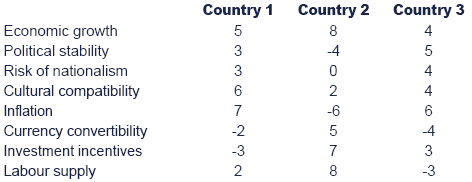
The consultant suggests that economic growth and political stability are twice as important as the other factors.
The consultant states in the report that previous clients have notinvested in countries with total weighted score of less that 30 out of amaximum possible 100 (with economic growth and political stabilitydouble weighted). The consultant therefore recommends that no investmentin Africa should be undertaken.
Required:
(a) Discuss whether or not Beelaelectronics should use the technique suggested by the consultant inorder to decide whether or not to invest in Africa.
(8 marks)
(b) Discuss briefly how Beela might manage political risk if it decides to invest in Africa.
(7 marks)
(Total: 15 marks)

13 Hedging foreign exchange risk
There are no additional questions on this chapter.
14 Hedging interest rate risk

 Murwald (Interest rate hedging)
Murwald (Interest rate hedging)
The corporate treasury team of Murwald plc are debating whatstrategy to adopt towards interest rate risk management. The company'sfinancial projections show an expected cash deficit in three months timeof £12 million, which will last for a period of approximately sixmonths. Base rate is currently 6% per year, and Murwald can borrow at1.5% over base, or invest at 1% below base. The treasury team believethat economic pressures in the euro zone will soon force the EuropeanCentral Bank (ECB) to raise interest rates on the euro by 2% per year,which could lead to a similar rise in UK interest rates. The ECB move isnot certain, as there has recently been significant economic pressureon the bank from the governments of euro zone countries not to raiseinterest rates.
In the UK, the economy is still recovering from a recession andrepresentatives of industry are calling for interest rates to be cut by1%. Opposing representations are being made by pensioners, who do notwish their investment income to fall further due to an interest ratecut.
The corporate treasury team believes that interest rates are morelikely to rise than to fall, and does not want interest payments duringthe six month period to increase by more than £10,000 from the amountsthat would be paid at current interest rates. It is now 1 December.
Euronext.liffe prices (1 December)
Futures
£500,000 three month sterling interest rate (points of 100%)

Options
£500,000 short sterling options (points of 100%)
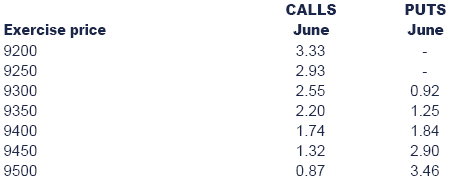
Required:
(a) Illustrate results of futures and options hedges if, by 1 March:
(i)Interest rates rise by 2%. Futures prices move by 1.8%.
(ii) Interest rates fall by 1%. Futures prices move by 0.9%.
Recommend with reasons, how Murwald plc should hedge itsinterest rate exposure. All relevant calculations must be shown.Taxation, transactions costs and margin requirements may be ignored.State clearly any assumptions that you make.
(b) Discuss the advantages and disadvantages of other derivative products that Murwald might have used to hedge the risk.

15 The economic environment for multinationals

 Growth of multinationals
Growth of multinationals
Question
The global turnover of the largest multinational companies is greater than the gross national product of many countries.
Discuss factors that might explain the successful growth of large multinational companies.
(10 marks)

16 International money markets and complex financial instruments
There are no additional questions on this chapter.
17 Topical issues in financial management
There are no additional questions on this chapter.
Test your understanding answers

 Influence on objectives
Influence on objectives
Answer
Non-financial issues, ethical and environmental issues in manycases overlap, and have become of increasing significance to theachievement of primary financial objectives such as the maximisation ofshareholder wealth. Most companies have a series of secondary objectivesthat encompass many of these issues.
Traditional non-financial issues affecting companies include:
(i)Measures that increase the welfare of employeessuch as the provision of housing, good and safe working conditions,social and recreational facilities. These might also relate to managersand encompass generous perquisites.
(ii) Welfare of the local community and society as a whole.This has become of increasing significance, with companies acceptingthat they have some responsibility beyond their normal stakeholders inthat their actions may impact on the environment and the quality of lifeof third parties.
(iii)Provision of, or fulfilment of, a service.Many organisations, both in the public sector and private sectorprovide a service, for example to remote communities, which would not beprovided on purely economic grounds.
(iv)Growth of an organisation, which might bring more power, prestige, and a larger market share, but might adversely affect shareholder wealth.
(v) Quality. Many engineering companies have been accused of focusing upon quality rather than cost effective solutions.
(vi)Survival. Although tosome extent linked to financial objectives, managers might placecorporate survival (and hence retaining their jobs) ahead of wealthmaximisation. An obvious effect might be to avoid undertaking riskyinvestments.
Ethical issues of companies were brought into sharp focus by the actions of Enron and others.
There is a trade-off between applying a high standard of ethics andincreasing cash flow or maximisation of shareholder wealth. A companymight face ethical dilemmas with respect to the amount and accuracy ofinformation it provides to its stakeholders. An ethical issue attractingmuch attention is the possible payment of excessive remuneration tosenior directors, including very large bonuses and ‘goldenparachutes’.
Key answer tips
Should bribes be paid in order to facilitate the company’slong-term aims? Are wages being paid in some countries below subsistencelevels? Should they be? Are working conditions of an acceptablestandard? Do the company’s activities involve experiments on animals,genetic modifications etc? Should the company deal with or operate incountries that have a poor record of human rights? What is the impact ofthe company’s actions on pollution or other aspects of the localenvironment?
Environmental issues might have very direct effects oncompanies. If natural resources become depleted the company may not beable to sustain its activities, weather and climatic factors caninfluence the achievement of corporate objectives through their impacton crops, the availability of water etc. Extreme environmental disasterssuch as typhoons, floods, earthquakes, and volcanic eruptions will alsoimpact on companies’ cash flow, as will obvious environmentalconsiderations such as the location of mountains, deserts, orcommunications facilities. Should companies develop new technologiesthat will improve the environment, such as cleaner petrol or alternativefuels? Such developments might not be the cheapest alternative.
Environmental legislation is a major influence in manycountries. This includes limitations on where operations may be locatedand in what form, and regulations regarding waste products, noise andphysicalpollutants.
All of these issues have received considerable publicity and attention in recent years. Environmental pressure groupsare prominent in many countries; companies are now producing social andenvironmental accounting reports, and/or corporate socialresponsibility reports. Companies increasingly have multiple objectivesthat address some or all of these three issues. In the short-termnon-financial, ethical and environmental issues might result in areduction in shareholder wealth; in the longer term it is argued thatonly companies that address these issues will succeed.


 Breckhall
Breckhall
Answer
(a) As there is more than one inflation rate, we must calculate themoney cash flows and hence discount them by the money (nominal) rate.
Net present value calculation for Breckhall Inc
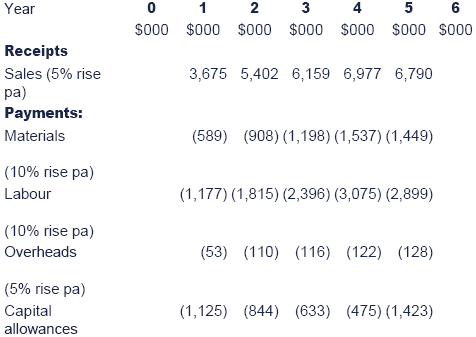

A positive NPV is when the expected return on a project morethan compensates the investor for the perceived level of (systematic)risk.
W1: Capital allowances calculation
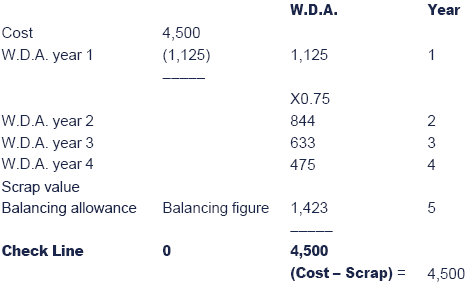
W2: Working capital requirements

W3: Sales - $3,500,000*1.05 = $3,675,000
$4,900,000*1.052 = $5,402,000 etc.
(b) Calculation of IRR
15% gave a positive NPV, therefore I will choose a higher discountrate to try and achieve a negative NPV, to enable the calculation of theIRR by linear interpolation. Under exam conditions I would simply pickthe highest discount rate from the tables i.e. 20%.
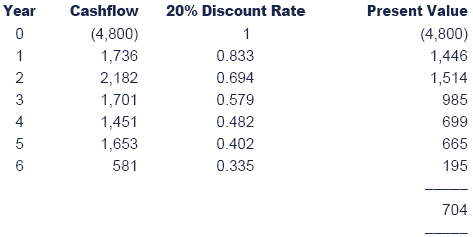
The estimate of the IRR by extrapolation: 15 + ((1382/1382 - 704) × (20 - 15)) = 25.20%


 Goddard Inc
Goddard Inc
Answer
(a) The overview – What method should I use to calculate the discount ratefor a project in a different industry (different business risk), whenthe capital structure of our company remains unchanged (same financialrisk) post project implementation.
The Leisure Project
I have assumed the business risk (the beta asset) of theleisure industry can be estimated by de-gearing the equity beta ofCottons plc.
Goddard’s existing gearing ratio/capital structure based on market values is:

Cotton’s gearing ratio/capital structure based on market values is:

(1) Find the business risk asset beta ßa of the new project/industry.
(2) Calculate the equity beta of the new project.
(3) Keg
Rf + (RM – R f) ße.
6% + (14 – 6) 1.53 = 18.24%.
(4) Kdat
The investors’ required return = Kd = 11%. Therefore to find the current cost of debt adjust for the tax relief on interest.
Kd(1 - t) = 11(0.70) = 7.70.
Kd(1 - t) = 7.70%.
(5) WACC
= 18.24% × 0.66 + 7.70% × 0.34 = 14.66%.
The Publication Project
I have assumed the business risk (the beta asset) of thepublication industry can be estimated by de-gearing the equity beta ofBlackwell plc.
Blackwell’s gearing ratio/capital structure based on market values is:

As the gearing ratio/financial risk of Blackwellis almost identical to that of Goddard, there is no need to take out thefinancial risk (degear) and then put back in the same level offinancial risk (re gear).
(3) Keg
Rf + (RM – Rf) ße.
6% + (14 – 6) 1.2 = 15.60%.
(4) Kdat
(5) WACC
= 15.60 × 0.66 + 7.7 × 0.34 = 12.91.
(b) The marketing directormight be correct. If there is initially a high level of systematic riskin the packaging investment before it is certain whether the investmentwill succeed or fail, it is logical to discount cash flows for this highrisk period at a rate reflecting this risk. Once it has been determinedwhether the project will be successful, risk may return to a ‘morenormal’ level and the discount rate reduced commensurate with thelower risk. If the project fails there is no risk (the company has acertain failure!).
The other board member is incorrect. If the same discount rate isused throughout a project’s life the discount factor becomes smallerand effectively allows a greater deduction for risk for more discountcash flows. The total risk adjustment is greater the further into thefuture cash flows are considered. It is not necessary to discount moredistant cash flows at a higher rate.


 HGT Inc
HGT Inc
Answer
Key answer tips
What appears to be an amazingly complex question for 10 marks isnothing much more than a relevant cost exercise. That said, the numberstake time and it would be sensible, if short of time, to cover thediscussion points with assumed numbers if necessary.
Under the current scheme:

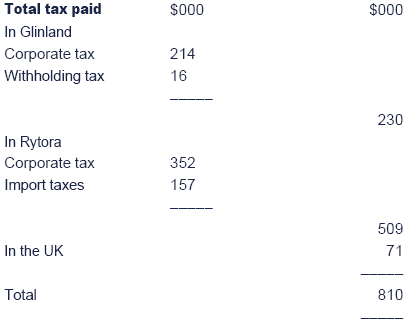
If goods are sold at cost by the Glinland subsidiary (i.e. at variable cost of 900 + fixed costs of 140 = 1,040):


The proposed change would result in an overall saving of $123,000 per year.
The proposal might not be acceptable to:
(i) The tax authorities inGlinland, where $230,000 in taxation would be lost. The tax authoritiesmight insist on an arm's length price for transfers between Glinland andRytora.
(ii) The subsidiary in Glinland,which would no longer make a profit, or have retentions available forfuture investment in Glinland. Depending upon how performance inGlinland was evaluated, this might adversely affect rewards andmotivation in Glinland.


 Axmine
Axmine
Answer
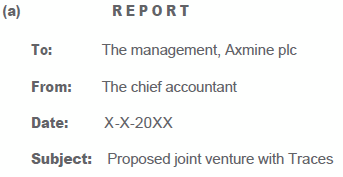
Introduction
Axmine plc is considering entering into a joint venture with Traces in order to import copper from XX country in South America.
Financial analysis
The discounting exercise reveals that the projected cash flows have a positive net present value of £4.71m.
Once this decision has been made public the share price willincrease if the market is at least semi strong efficient. Therefore asdirectors can you can achieve your primary duty, which is to maximiseshareholders wealth.
Accuracy and completeness of cash flows
Be question specific
The price of copper grows by 10% pa in sterling terms. Metalsprices are notoriously volatile and the implications of this assumptionshould be investigated.
The justification of the discount rate is unreliable, i.e. the16% minus 2%, as this does not appear to reflect the systematic risk ofthis project.
General comments
Purchasing Power Parity Theory can be used as our best predictor of future spot rates, however it is not accurate because of the following:
- The future inflation rates are only estimates.
- The market is dominated by speculative transactions (98%) as opposed to trade transactions; therefore purchasing power theory breaks down.
Are the various revenues and costs likely to be subject to the same level of inflation?
Corporate tax rates and tax allowances may change over the project life.
Risk analysis
General risk comment
When accepting a project we also accept the risk associatedwith that project. Thus I would suggest we analysis the project risk inmore detail before accepting the project. The level of analysis willdepend on the complexity and materiality of the project. The risk can beanalysed in a number of ways, i.e. sensitive analysis, scenarioanalysis, and simulation analysis.
International risk comment
Axmine should undertaken a political risk assessment, it mayadopt both macro and micro techniques to help reach its evaluation.Joint ventures have historically been more at risk of expropriation byhost governments than wholly owned subsidiaries (Bradley 1977). A reviewof economic exposure should also be undertaken.
Qualitative factors
The relationship with Traces
Will Traces honour its obligations under the joint venture?What will happen at the end of the four years? Will Traces have acquiredall the technical knowledge to be able go it alone? Why is the initialperiod only for four years? Would it benefit Axmine to have this periodextended?
Communication to sophisticated shareholders
Will our shareholders believe it is a worthwhile project to beundertaken? Does the project fit into our previously communicatedstrategy? Our shareholders’ confidence is crucial to maintaining orincreasing our share price.
Future opportunities
Axmine should undertake a review of all real options.
Affect on other stakeholders
Employees, creditors, debentures holders and the local community.
Managerial resources
Have we the in hose managerial resources to deliver thisproject. What will the impact be, on our current operationalcapabilities?
Conclusions and recommendations
It is therefore concluded that the joint venture should beproceeded with in the absence of any more lucrative proposals, subjectto clarification of the above reservations.
Workings
W1 Estimated future exchange rates: based on PPPT
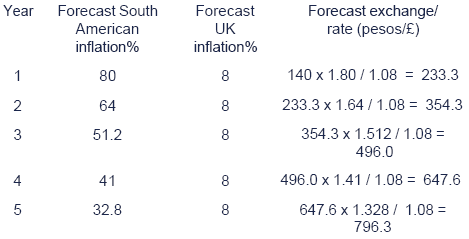
W2 Sales

W3 Labour and other expenses

W4 Supervisors’ costs

W5 UK tax on foreign taxable profits
Tax has been paid in South America at only 20%. A further 15% is therefore payable in the UK.

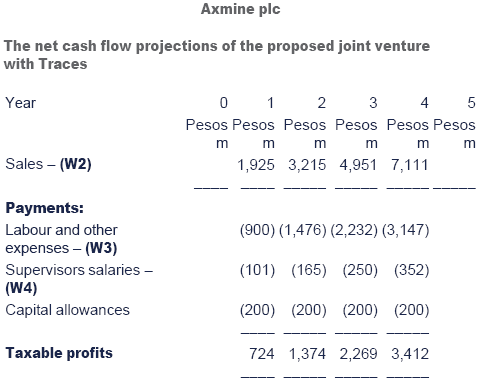

(b) Is the proposed discount rate of 14% appropriate?
The first point is the each discount rate must be bespoke, i.e.calculated specifically for each project and based on the perceivedsystematic risk of the inherent cash flows of that project. To base thediscount rate of the foreign project on the rate for UK miningoperations is not satisfactory as the systematic risk of the project maybe significantly different.
The logic of the 2% reduction is also questionable:
One argument put forward for overseas expansion is that of riskdiversification, i.e. that the income of the combined company will beless volatile as its cash flows come from a variety of markets. However,this is a reduction in total risk, but has little or no affect on thesystematic risk.
Will this benefit the shareholders?
Basic answer: No
Shareholders should diversify for themselves, because ashareholder can more easily and cheaply eliminate unsystematic risk bypurchasing an international unit trust.
If the diversification is into foreign markets where theindividuals cannot directly invest themselves this may lead to areduction in their systematic risk.
This could be possible for a South American country, whereexchange controls and other market imperfections often exist. However,as it gets easier for individuals to gain access to foreign markets thevalue of this argument has diminished.
(c)Blocked remittances might be avoided by means of:
(1) Increasing transfer prices paid by the foreign subsidiary to the parent company.
(2) Lending the equivalent of the dividend to the parent company.
(3) Making payments to the parent company in the form of royalties, payment for patents, or management fees.
(4) Charging the subsidiary additional head office overhead.
(5) Parallel loans, wherebythe subsidiary in the South American country lends cash to thesubsidiary of another a company requiring funds in the South Americancountry. In return the parent company would receive the loan of anequivalent amount of cash in the UK from the other subsidiary’s parentcompany.
The government of the South American country might try to prevent many of these measures being used.


 Option valuation
Option valuation
Answer
(a) Option valuation
First use Black-Scholes to value the equivalent call.
Step 1 Calculate d1 and d2
d1 = [ln (Pa/Pe ) + (r+0.5s2)t] / s√ t
d1 = [ln (6/5) + (0.12+0.5 × 0.32)2] / (0.3 × √ 2)
d1 = 1.21
d2 = d1- s√ t = 1.21 - 0.3√ 2
d2= 0.79

(Reasonableness check: this exceeds the intrinsic value of $1.00 so it looks ok.)
Step 4 Then use the put call parity rule to value a put option.

= $2.24 + $3.93 – $6.00 = value of a put
= $0.17
200,000 puts would therefore cost
= 200,000* 0.17
= $34,000
(Reasonableness check: this option is out of the money so we would expect a low value.)
(b)

Shares with Put options

The hedge would save $366,000 ($600,000 – $234,000) if theshare price fell, and would lose $34,000 if the share price increasedi.e. the cost of the options that were not exercised.
(c) The investor purchased200,000 shares and wishes to hedge the position, how many call optionswould he have to sell to construct a risk free investment?
= 200,000 / 0.8869 = Sell 225,505 call options


 Rayswood Inc
Rayswood Inc
Answer
Assumptions:
(1) Share price is the present value of future cash flows i.e. the economic model.
(2) The stock market is weak and semi strong efficient most of the time,therefore once new information is communicated to the market it israpidly reflected in the share price.
(3) In an efficient market shares are fairly priced i.e. a zero NPVtransaction. They give investors the exact return to compensate them forthe perceived level of systematic risk of the shares.
(4) If shares are zero NPV transactions, takeovers/mergers could only besuccessful due to value created as a result of the merger i.e. thesynergies.
(5) Therefore it is absolutely essential that one undertakes an exhaustivereview to identify all the synergies. In this question no synergies havebeen identified, therefore before any final advice would be given tothe client one would request an immediate review of all synergies.
(6) The question will therefore have to be answered on the basis of the unrealistic assumption that there are no synergies.
Post acquisition share price:

Rayswood buys Pondhill in a 1 for 6 shares for share exchange.Rayswood already has 40m shares and buys Pondhill for (150 × 1/6) = 25mshares, thus 65m shares in total.
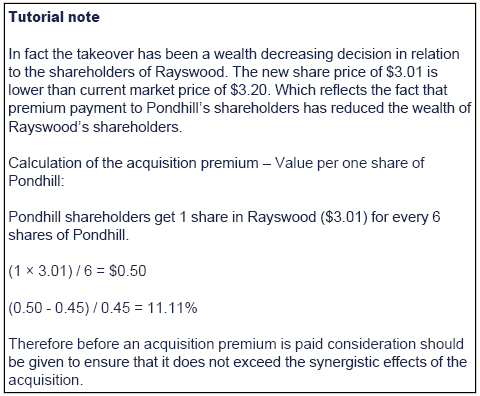
Director’s comments:
‘As a result of this takeover we will diversify our operationsand our earnings per share will rise by 13%, bringing great benefits toour shareholders.’
Risk diversification:
One of the primary reasons put forward for all mergers is that theincome of the combined entity will be less volatile (less risky) as itscash flows come from a wide variety of products and markets. Howeverthis is a reduction in total risk, but has little or no affect on thesystematic risk.
Will this benefit the shareholders?
Basic answer: No. Shareholders should diversify for themselves,because a shareholder can more easily and cheaply eliminate unsystematicrisk by purchasing an international unit trust. As the majority ofinvestors in quoted companies have well diversified portfolios they areonly exposed to systematic risk. Thus the reduction of total risk by themore expensive company diversification option is generally notrecommended. The Director’s comment is incorrect.
Earnings per share will rise by 13%:
Calculation of EPS:

% increase in the Earnings per share: (22 – 19.5) / 19.5 × 100 = 13%
An increasing EPS does not automatically result in an increaseshare price, as the P/E ratio may fall to reflect the lower growthpotential of the enlarged company.
The P/E ratios:

In the absence of synergy from the acquisition, purchasingPondhill, with relatively low growth expectations, will depress thegrowth of the enlarged Rayswood’s post acquisition and thus the postacquisition P/E ratio falls.
The Director’s comment is incorrect, the increasing earnings pershares does not bring great benefits to the shareholders, in fact itmasks a potential decrease in the share price.
Non-executive comments:
“The share price of Rayswood will rapidly increase to $3.61 following the announcement of the bid.â€
Bootstrapping:
A company is able to increase its EPS by merging with a company on alower P/E ratio than its own. The bootstrapping argument states thatthe

It contends that the market may believe that when that merger iscompleted that the management team of Rayswood can increase growthpotential of Pondhill earnings to the same level as Rayswood earnings.It may then assign the Rayswood’s higher P/E ratio to the combinedearnings of both companies (i.e. the post acquisition EPS).
There has been some well documented cases of bootstrappingoccurring in the 50s and 60s in America however as the stock marketshave become more and more efficient it much less likely to occur today.The investors would request a detail analysis of the synergies so theycould calculate the present value of future cash flows.
If there are no synergies identified the higher post acquisitionEPS simply results in a lower post acquisition P/E multiple as we haveseen. Therefore the non-executive is also incorrect in his views.


 Predator
Predator
Answer
Predator Inc
The approaches to use for valuation are:
(1) Net asset valuation.
(2) Dividend valuation model.
(3) P/E ratio valuation.
(1) Net asset valuation
Target is being purchased as a going concern, so realisable values are irrelevant.
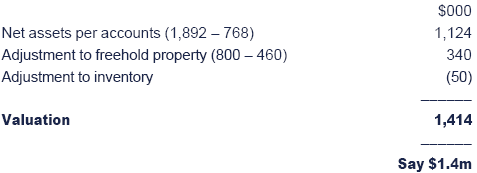
(2) Dividend Valuation Model
The average rate of growth in Target’s dividends over the last 4 years is 7.4% on a compound basis.
The estimated value of Target using the dividend valuation model is therefore:

(3) P/E ratio Valuation
A suitable P/E ratio for Target will be based on the P/E ratio of Predator as both companies are in the same industry.
P/E of Predator (70m × $4.30) / $20.04m or 430 / 28.63 = 15.02
The adjustments: – Downwards by 20% or 0.20 i.e. multiply by 0.80.
(1) Target is a private company and its shares may be less liquid.
(2) Target is a private company and it may have a less detailed compliance environment and therefore maybe more risky.
A suitable P/E ratio is therefore 15.02 × 0.80 = 12.02 (Multiplying by 0.80 results in the 20% reduction).
Target’s PAT + Synergy after tax:
$183,000 + ($40,000 × 67%) = $209,800.
After adjusting for the savings in the director’s remuneration.
The estimated value is therefore $209,800 × 12.02 = $2,521,796
Say $2.5m
Advice to the board
On the basis of its tangible assets the value of Target is $1.4m, which excludes any value for intangibles.
The dividend valuation gives a value of around $1.6m.
The earnings based valuation indicates a value of around $2.5m,which is based on the assumption, that not only will the currentearnings be maintained, but that they will increase by the savings inthe director’s remuneration.
On the basis of these valuations an offer of around $2m would appear to be most suitable, however a review of all potential synergies is recommended. The directors should, however, be prepared to increase the offer to maximum price.
Maximum price comment
It is worth noting that the maximum price Predator should be prepared to offer is:
The maximum price Predator should pay for target is:
PVTarget Company + PVSynergy
The comment on the maximum price is particularly appropriate inthis question, as this an example of horizontal acquisition whereconsiderable synergies normally exist.


 Last Chance Saloon Inc
Last Chance Saloon Inc
Answer
Report on the proposed reconstruction scheme of The Last Chance Saloon
The scheme of reconstruction is likely to be successful if:
A It raises adequate finance.
B If the issue price of the new shares is fair.
C It treats all parties fairly.
D No group is worst off under the scheme.
The reason why the scheme is required
As a result of the recent considerable losses there is inadequatefunds available to finance the redemption of the $5m debentures in 20X5.
Does the scheme raise adequate finance?
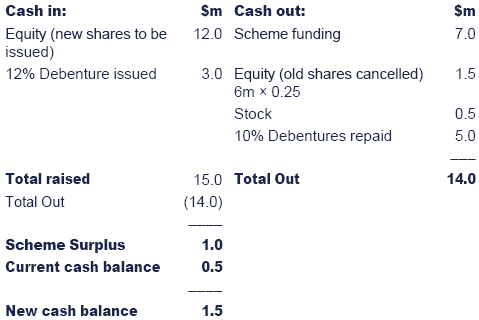
The Capital Repayment position
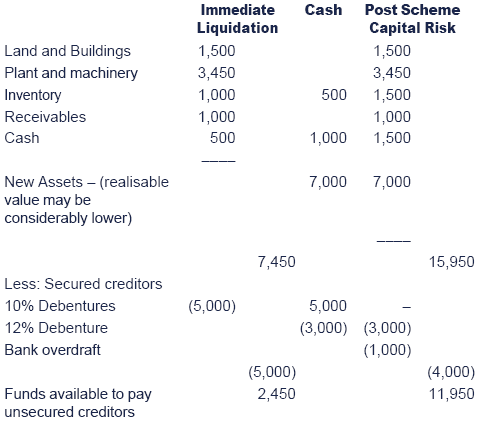

An estimate of the liquidation expenses to be incurred would be necessary in practice.
Is the issue price of the new shares fair?
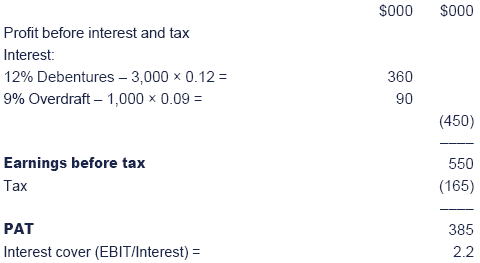
The interest cover is below the minimum acceptable level of 2.5 times and is therefore cause for concern.
E.P.S = PAT / No. of Shares = 385 / 10,000 = 3.85c
P/E ratio: Issue price / E.P.S
120c / 3.85 = 31.17 times
Assume that the industry average P/E is 16 times. Therefore wouldinvestors also be willing to pay 31.17 times the estimated earnings ofLast Chance for a share?
The answer is no, they would want to be able to buy the shares at adiscount given the fact that earnings would be perceived to be lessreliable as a result of its recent poor performance. Therefore thecurrent issue price may be unacceptable to investors.
A discount of 25% would seem reasonable i.e. 16 times × 0.75 = 12times. Then a more reasonable issue price would appear to be 3.85c × 12times = 46.2c.
Conclusion: The shares could not be sold for $1.20. Thus thefinancial viability of the scheme is called into question. (As the 12mcash in from the issue of new shares will not occur.)
Is the scheme acceptable to all parties?
Unsecured creditors:
In the event of liquidation they would receive 70c in the pound(ignoring liquidation expenses). However under the scheme they shouldreceive a full repayment. The scheme is clearly beneficial to them.
The Bank:

The reality of the situation is that the scheme will be organised(and the overdraft will be $1m) or the company will be liquidated andthe bank will only receive $840,000. The current position of anoverdraft of $1.2m as denoted in the balance sheet is a sunk position.
Thus the bank has a simple choice have $840,000 on liquidation oragree to a reduced overdraft of $1,000,000 under the scheme, which willbe secured. If the bank agrees to the scheme the capital loss on theoverdraft is reduced from $360,000 to $160,000 – a saving of $200,000.
Thus the bank will probably agree to the reduced overdraft (thus the reduced overdraft does not give rise to a cash flow).
However the low interest cover would be of concern to the Bank, andraises doubts about the company’s ability to repay the interest.Therefore the bank may which to scrutinise the company profit forecastsin some details to ensure that they are based on realistic assumptions.
Existing Shareholders:

The current share of 22c does not represent a realistic exitstrategy of all the existing shareholders, because if a sizeableproportion of shareholders try to sell, this would drive down the shareprice.
Thus existing shareholders will probably agree to the scheme.
The company may consider offering the existing shareholders a sharefor share exchange as opposed to offering them a cash repayment as thiswould reduce the need for financing and allow those existingshareholders who wish to remain the opportunity to do so.
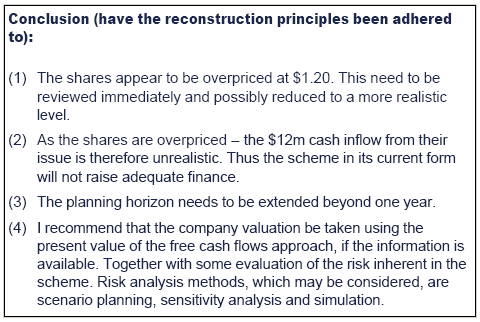


 Political risk
Political risk
Answer
(a) The consultant’s report should not be used as the only basis for the African investment decision, for the following reasons.
(i)The decision should betaken after evaluating the risk/return trade-off; financial factors(e.g. the expected NPV from the investments); strategic factors; andother issues including political risk. Political risk is only one partof the decision process (although in extremely risky countries it mightbe the most important one).
(ii) The scores for the three countries are, giving double weighting to economic growth and political stability:

Just because previous clients have not invested incountries with scores of less than 30 does not mean that Beela shouldnot. The previous countries may not have been comparable with these inAfrica. This decision rule also ignores return. If return is expected tobe very high, a relatively low score might be acceptable to Beela.
(iii)The factors consideredby the consultant might not be the only relevant factors when assessingpolitical risk. Others could include the extent of capital flight fromthe country, the legal infrastructure, availability of local finance andthe existence of special taxes and regulations for multinationalcompanies.
(iv)The weightings of the factors might not be relevant to Beela.
(v)Scores such as these onlyfocus on the macro risk of the country. The micro risk, the risk forthe actual company investing in a country, is the vital factor. Thisdiffers between companies and between industries. A relatively hi-techelectronics company might be less susceptible to political actions than,for example, companies in extractive industries where the diminishingbargain concept may apply.
(vi)There is no evidence of how the scores have been devised and how valid they are.
(b) Prior to investing Beelamight negotiate an agreement with the local government covering areas ofpossible contention such as dividend remittance, transfer pricing,taxation, the use of local labour and capital, and exchange controls.The problem with such negotiations is that governments might change, anda new government might not honour the agreement.
The logistics of the investment may also influence political risk:
(i)If a key element of theprocess is left outside the country it may not be viable for thegovernment to take actions against a company as it could not produce acomplete product. This particularly applies when intellectual propertyor know-how is kept back.
(ii) Financing locally might deter political action, as effectively the action will hurt the local providers of finance.
(iii)Local sourcing of components and raw materials might reduce risk.
(iv)It is sometimes arguedthat participating in joint ventures with a local partner reducespolitical risk, although evidence of this is not conclusive.
(v) Control of patents and processes by the multinational might reduce risk, although patents are not recognised in all countries.
Governments or commercial agencies in multinationals’ home countries often offer insurance against political risk.


 Murwald (Interest rate hedging)
Murwald (Interest rate hedging)
(a) The treasury team believe thatinterest rates are more likely to increase than to decrease, and anyhedging strategy will be based upon this assumption. There is also arequirement that interest payments do not increase by more than £10,000from current interest rates.
Current expectations
The current expectation is a £12m deficit in three months’time for a six-month period. At current rates, the company could borrowat 6% + 1.5% = 7.5%. Interest costs at current borrowing rates wouldtherefore be: £12m * 7.5% * 6/12 = £450,000.
Alternative 1: Futures hedges (Either March or June contracts may be used, or both. This suggested solution uses June contracts.)
Use June contracts to hedge a deficit of £12 million. To hedgeagainst the risk of a rise in interest rates, the company should sellfutures.
Tutorial note: We sell futures because if interest ratesdo rise, the market price of the futures will fall. The company canthen close its position by buying futures, and making a gain on thefutures trading to offset the ‘loss’ from higher interest rates inthe loans market.
(i)If interest rates rise by 2% and the futures price moves by 1.80%
As a six months hedge is required and each future is for athree-month interest period, the number of contracts will be £12m /£500k x 6/3 = 48 contracts
The tick value is £500,000 * 0.0001 * 3/12 = £12.50

(ii) If interest rates fall by 1% and the futures price moves by 0.9%
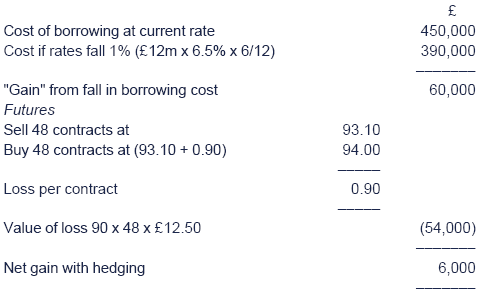
Based on these futures prices, hedging in the futuresmarket does not allow the company to guarantee that interest costs inthe case of a deficit do not increase by more than £10,000.
Alternative 2: Options hedges
The expectation is for interest rates to rise, therefore putoptions on futures will be purchased. This will allow the company tosell futures contracts at the exercise price for the options. Thecompany should buy 48 options, since this is the number of futurescontracts that might be required. (If interest rates rise the value ofthe put options will also increase.)
For example using the 9400 exercise price:
(i)If interest rates rise by 2% and the futures price moves by 1.8%

In reality the options are likely to be sold rather thanexercised. This is because they are June contracts, so they will stillhave time value that will be reflected in the option price. The gainfrom the options sale is therefore likely to be higher than the gainfrom exercising the options and selling futures. However, no data isprovided on option prices on 1 March.
(ii) If interest rates fall by 1% and the futures price moves by 0.9%
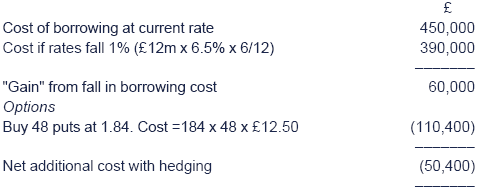
Different outcomes will exist for using options if different putoption exercise prices are selected. The best exercise price to selectif the put options are exercised will be the 9350 option.
If interest rates rise by 2% and the futures price falls by 180 to 91.30, this will give a gain from the options of:
93.50 – 91.30 – 1.25 = 0.95 or 95 ticks
95 × 48 × £12.50 = £57,000
If interest rates fall by 1% and the futures price rises to thefutures price moves to 94.00, the option will not be exercised. The lossfrom hedging with options will be the premium paid of:
125 × 48 × £12.5 = £75,000
Outcomes with options at 9350
2% increase: £(120,000) + £57,000 = £(63,000)
1% decrease: £60,000 – £75,000 = £(15,000).
Neither futures nor options hedges can satisfy, with certainty, therequirement that the interest payment should not increase by more than£10,000.
Collar
However, one way to achieve this would be to use a collar option,whereby downside risk is protected, but potential gains are alsolimited. A collar effectively fixes a maximum and minimum interest rate.
If a company expects to be borrowing and is worried about interestrate increases, a suitable collar can be achieved by buying put optionsand selling call options, to reduce the cost of protection.
For example a collar could be achieved by buying 48 9400 putoptions at 1.84 and selling 9400 call options at 1.74, a net premiumcost of 0.10 (other alternatives are possible).
Murwald doesn't want interest to move adversely by more than £10,000 for a six month period on a £12 million loan.
In annual terms this is a £10k/£12m × 2 = 0.167%
A put option at the current interest rate (6%) and a total premiumcost of less than 0.167% will satisfy the company's requirement. In theabove example the total premium cost is 0.10%, and no matter whathappens to interest rates Murwald can fix its borrowing cost at 7.6% (=100 - 94.00 + 0.10 net option premium, plus the 1.5% premium over baserate for borrowing).
This satisfies the requirement. (Interest payments would be £12m *7.6% * 0.5 = £456,000 which is £6,000 worse than current interestrates.)
The use of a collar is the recommended hedging strategy, but thecompany should consider the implications of the collar if a cash surpluswere to occur rather than a cash deficit.
(i)Alternative interest rate hedges include:
(i)Forward rate agreements (FRAs).
(ii) OTC interest rate options - including interest rate guarantees.
(iii)Interest rate swaps.
(i)A forward rate agreement (FRA)is a contract to agree to pay a fixed interest rate that is effective ata future date. As such Murwald could fix now a rate of interest of 6.1%(for example) to be effective in three months time for a period of sixmonths. If interest rates were to rise above 6.1% the counter-party,usually a bank, would compensate Murwald for the difference between theactual rates and 6.1%. If interest rates were to fall below 6.1% Murwaldwould compensate the counter-party for the difference between 6.1% andthe actual rate.
(ii) OTC options. Instead ofmarket traded interest rate options such as those that are available onLIFFE, Murwald might use OTC options through a major bank. This wouldallow options to be tailored to the company's exact size and maturityrequirements. An OTC collar would be possible, and the cost of thisshould be compared with the cost of using LIFFE options. Interest rateoptions for periods of less than one year are sometimes known asinterest rate guarantees.
(iii)Interest rate swaps.Murwald expects to borrow at a floating rate of interest. It might bepossible for Murwald to swap its floating rate interest stream for afixed rate stream, pegging interest rates to approximately currentlevels (the terms of the swap would have to be negotiated). Interestrate swaps are normally for longer periods than six months.


 Growth of multinationals
Growth of multinationals
Answer
Growth of multinationals
Multinational companies are normally able to take more advantage ofimperfections in product markets, factor markets or financial marketsthan companies that only operate in a domestic market. Taking advantageof market imperfections gives a competitive advantage and facilitatesthe organic growth of multinationals. By virtue of their size they arealso well placed to grow through acquisition, often in the form ofvertical or horizontal integration.
Many market imperfections result from government actions, forexample through tariffs, quotas, exchange controls, and investmentincentives. Multinationals often avoid government imposed barriersthrough foreign direct investment, and may take advantage of favourabletax and other incentives.
Multinationals may benefit from locating production in differentcountries in order to take full advantage of economies of scale andscope, low labour costs, and control of raw material supplies. Economiesof scale and scope may be in production (operating at an optimum unitsize, and specialising production in those countries where comparativeadvantages are greatest), purchasing (quantity discounts and use ofmarket power), marketing (utilising an internationally known brandimage, and an efficient international marketing structure), research anddevelopment (superior technology and/or differentiated products) orfinancing (access to international financial markets with the potentialto raise finance at relatively low cost, and to earn higher yields onfinancial investments). Multinationals also often have the ability toreduce their global tax payments by locating activities in tax efficientcountries, reducing taxable income or shifting tax liability from onecountry to another through devices such as transfer pricing, royaltyfees and management fees, and eliminating or deferring taxation throughthe use of tax havens.
In many countries multinationals may be in an oligopolistic or evenmonopolistic situation, which may be exploited to generate abnormallygood profitability and growth.
Internalisation of comparative advantages
Competitive advantage can be maintained by possession of uniqueinformation and skills which employees can use to create furtheradvantage through research and development, marketing and othercommercial skills. The multinational company is motivated to create aninternal market for this information and to keep possession of theirunique advantage specific to the firm.
Taking advantage of market imperfections is important, but aprerequisite for a successful multinational is high quality management,and the ability to survive against other multinationals in a competitiveworld.

|
Created at 5/24/2012 4:00 PM by System Account
(GMT) Greenwich Mean Time : Dublin, Edinburgh, Lisbon, London
|
Last modified at 5/25/2012 12:55 PM by System Account
(GMT) Greenwich Mean Time : Dublin, Edinburgh, Lisbon, London
|
|
|
|
 |
Rating
:
|
 Ratings & Comments
(Click the stars to rate the page) Ratings & Comments
(Click the stars to rate the page)
|
 |
Tags:
|
|
|
|
|